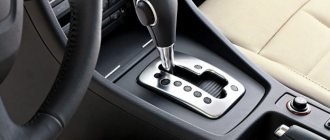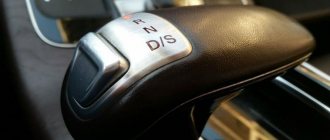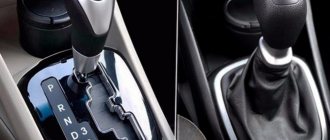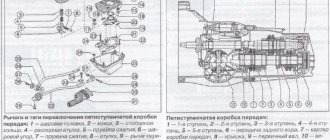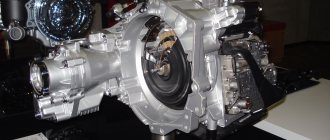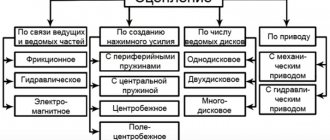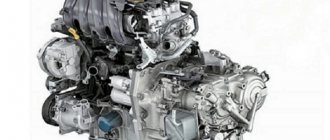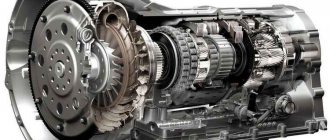Mitsubishi Outlander CVT repair
When cars with continuously variable transmissions began to be widely imported into the Russian Federation, ideas about their strength, advantages and disadvantages regularly differ. The term “variator” (CVT) has become like a horror story for many drivers. Regarding them, they began to say that this type of transmission is unsuitable for repair work, unreliable, and absolutely not adapted to Russian roads. So, can you rely on the safety of the Mitsubishi Outlander CVT?
Not long ago, all Japanese manufacturers began installing V-belt gearboxes on their cars. Why equip the latest car modifications, sold almost all over the world, with non-viable transmission systems? In order to answer this question, it is necessary to understand whether CVTs are actually so unreliable, and whether it is necessary, in principle, to make a choice in their favor when purchasing a car?
In this case we will talk about V-belt CVT. This type of continuously variable transmission is considered more popular, since it is installed in cars with a capacity of up to 2 liters, and therefore also in Mitsubishi Outlander jeeps.
Is the Mitsubishi Outlander CVT reliable?
Mitsubishi Outlander XL CVT repair
If there is a question about the strength of any area in the machine, it is first necessary to analyze its service life. The Mitsubishi Outlander's CVT has the same feature, as do all continuously variable transmissions. Its service life is the same as the service life of a car.
For Japanese car manufacturers, this is logical. Why supply parts and components for a disposable gearbox? And if the variator breaks down, then its time has come, and it is easier to change the car to a new one than to try to repair the old one. In this case, if the car must travel 300 thousand kilometers, then during this period the variator should not break down. This shows that the CVT on the Mitsubishi Outlander is reliable.
This is in theory, but in practice it is not so perfect. The problem is that many conditions are ready to significantly reduce the period of operation of the CVT. These include bad roads, as manufacturers recommend avoiding driving on rough terrain, and incorrect use of the gearbox.
In the case of the variator on the Mitsubishi Outlander, its service life is from 150 to 200 thousand kilometers.
Many are still tormented by the question of what is preferable, CVT or step transmissions.
Mitsubishi Outlander CVT
It should be emphasized that all 3 types of gearboxes have pros and cons, so when buying a car with a CVT, the driver must understand the advantages and disadvantages of the gearbox.
CVT has the following advantages:
- a continuously variable transmission makes it possible to change the speed at the same speed;
- the car accelerates faster;
- the driver does not waste time changing gears;
- the car moves smoother, there are no shocks;
- fuel is saved.
Flaws:
- shortage of spare parts for replacement;
- Even for a crossover, it is not recommended to drive on bad roads, as this will most likely cause the device to fail.
CVT jatco
The JF011FE variator model from the Japanese company jatco is widely popular. Today, cars of such brands as Nissan, Citrien, Suzuki, Renault and Mitsubishi are equipped with these CVT gearboxes.
The manufacturer does not provide for the possibility of replacing the fluid, since it is filled in for the entire service life. But we must not forget about the peculiarities of Russian roads and the absence of a cooling radiator in the Mitsubishi Outlander XL, which leads to a loss of transmission fluid properties.
In conclusion, it is fashionable to provide a table with the disadvantages and advantages of the CVT on the Mitsubishi Outlander XL.
Automatic transmission repair with a 15% discount, ask the manager for details. Promotion time is limited!
Certified equipment
Our technicians use only certified equipment!
More than 10,000 working machines
Over our long history since 2003, we have repaired more than 10,000 automatic variable transmissions
Only the best masters
Some of the best masters in Moscow will work on your car, who have already repaired more than 100 gearboxes during their careers.
The continuously variable variator is an unusually convenient type of transmission. Its presence in cars is a guarantee of comfortable movement, both around the city and on the highway. The advantages of the variator are efficiency, stable driving dynamics and ease of use. But all this is possible only if all transmission elements are functioning properly. As soon as one of them fails, all the advantages of the variator disappear.
Mitsubishi variator repair is necessary in the following cases:
- the occurrence of slipping when starting the car and sudden jerks at the moment of its movement;
- the appearance of vibration and reduction in power, deterioration in driving dynamics;
- CVT fault signal on the dashboard;
- instability of power unit speed;
- impossibility of further operation of the vehicle due to its complete stop.
Prices for repairing a Mitsubishi variator
| Works | Price | A comment |
| Removal/installation | from 7,000\8,000 rubles | FWD, RWD\AWD |
| Major renovation | from 10,000 rubles | excluding cost of spare parts |
| Change of oil | from 1,100 rubles | excluding the cost of consumables |
| Torque converter repair | from 6,000 rubles | for severe damage, the price is approximately 20% higher |
| Car evacuation | for free | in case of cap. repairs |
| Automatic transmission diagnostics | from 1,000 rubles | included in the cost of repair |
How difficult is it to repair a variator, and how is it carried out?
This is not to say that parts for CVTs are not available on the market, you just need to look for them. In the CIS, the purchase of elements and repair of V-belt transmissions is carried out exclusively by Kensi Transmission. She worried not only about the supply of parts, but also about diagnostic equipment.
Service life of the Mitsubishi Outlander variator
Restoring a CVT cannot be called very difficult. A common problem with all malfunctions is the stretching of the metal belt, which leads to the gearbox slipping and the impossibility of its normal operation. The belt is held on by terminals, which also wear out over time. The only correct solution in this case is to change the belt. If necessary, then replace the terminals.
It seems that there is no difficulty here, if not for the lack of spare parts. At ordinary technical service stations they do this:
- purchase used CVTs;
- remove the necessary spare parts from them;
- install a belt on a CVT that requires repair work.
As a result, the owner of the car in this case plays the lottery: the chance that the belt on a used transmission will not stretch will be 50/50.
If you entrust the restoration of the variator, the result of the repair work will definitely be worthy, because new parts purchased from the original manufacturer will be installed on the gearbox.
In the first option, on 50% of repaired cars, slipping occurs again after about a week. In the second, the transmission takes on a new life and can last as long as the previous one, depending on the use of the car.
Repair warranty
High-quality CVT repair should include initial diagnostics (connecting a scanner and test drive), removing the transmission from the car, disassembling, reassembling, repairing the valve body, torque converter, oil pump and subsequent testing on the car. With this approach, complete CVT recovery takes 2-3 days
.
If somewhere you are promised to “fix the CVT in a day,” feel free to look for another service. We provide a guarantee of 12 months or 30,000 km
, provided that all the recommendations of the master are followed. In other words, if during the repair, in order to save money, all recommended work was not performed, we cannot give a guarantee for such a box. In the variator mechanism, everything is interconnected - one malfunction causes failures in other components, and in this case it will not be possible to get rid of it with partial repairs.
Typical diseases of the variator on Outlander
CVT for Outlander xl and its malfunctions
The standard CVT disease on the Outlander is regular overheating, especially in the summer. This is due to the fact that the Outlander does not have any kind of transmission cooling system. Therefore, when operating from 100 kilometers, it gets very hot. Therefore, the possibility of significant damage increases after several 10 thousand mileage.
The transmission may hum when the machine is running. More precisely, the bearings have failed. A popular problem is a stretched V-belt. However, these are common illnesses for all CVTs.
Belt slippage on cones
This malfunction is a consequence of the previous one. If the oil pump is not repaired in time, low pressure will lead to a mismatch in the operation of the driven and driving cones and, as a result, belt slippage. This imbalance causes scoring on the inner surfaces of the pulleys
. In this case, a more serious repair of the CVT Outlander will be required. At the initial stage, it is possible to restore the working surfaces by grinding. In case of serious damage, the cone is replaced, since mechanical treatment to a greater depth removes a thin layer of cementation. The service life of parts restored in this way will be negligible. When repairing cones, it is mandatory to change the steel balls in the grooves of the axle along which the shafts run (18 pieces, diameter 6 mm).
Cooling the variator when overheated
It is, of course, possible to eliminate overheating of the gearbox on a Mitsubishi Outlander.
Firstly, do not drive for a long time at high speeds. However, no one wants to put up with this inconvenience, because... the car is capable of more.
Cooling the Outlander variator through the radiator
Secondly, this is the installation of a cooling radiator. It’s good that you can buy a radiator for 10 times less than a gearbox; numerous car owners buy this service at service centers, while others install it themselves.
Reviews
We invite you to read reviews from owners of 2013 Mitsubishi Outlander crossovers.
| Positive | Negative |
| I bought an Outlander produced in 2013, I didn’t know anything about the variator at that time - well, “automatic” and “automatic”, but it behaves great! Maybe it’s because I’ve driven a manual all my life and switched to an elite crossover, but I’m happy with everything! The CVT is absolutely unpretentious; the only thing it needs is to change the oil on time. I changed it for the first time after 90 thousand kilometers, I came to the service station, they said - you need to change the transmission fluid every 60 thousand, otherwise it’s kaput. I changed the oil and filter twice, drove 160 thousand km, no complaints yet! | I also decided to leave a review. In general, your variator is complete crap! I often travel around big cities and it seems to me that this unit is clearly not for Moscow or Kyiv traffic jams! In such a dense traffic it is very difficult to change lanes, the variator needs extra time to “get it right”, and even with such dimensions, try to get through. The car was bought in 2013, a year later the reverse gear stopped engaging, I pulled it several times - everything was fine. Although I changed the oil in the box on time, I went to the dealer just in case, then to the service station - neither there nor there could give an intelligible answer why the speed would not turn on. |
| My 2013 Outlander has been used in very rough conditions. I don’t know what the Japanese meant when they wrote in the operating instructions that you can’t drive through the fields, but for two years I went to my dacha (and it’s not on Rublyovka) in the village a la Muho*sk. It’s not just off-road, it’s the real “**** of the world.” And somehow everything is normal! There are no questions, I took care of the gearbox, changed the filter and oil during the process, and everything was just “fire”! Only once, while driving on the highway, a light came on on the instrument panel saying “the variator has overheated” or something like that. Well, I was driving at about 140 km/h at that time. I slowed down to 90 km/h and there were no more problems. | I came here to complain! Today I had to take my 2013 Outlander to a service center. I've only driven 40,000, and it's not even time for an oil change yet. And as I was told, most likely I will have to change the variator. Do not repair, but rather replace, because such gearboxes cannot be repaired! A few days ago I started having jerks when moving, well, they were minor and went away quickly, so I didn’t attach any importance to it. And yesterday I was stuck in a traffic jam and my “iron horse” simply stalled and refused to go. A light with an exclamation mark came on on the instrument panel, but it was written there in English, so I don’t know what it means. I call the service, outline the situation, they tell me: “You can go, it’s okay, it happens that the electronics get stuck.” How to drive it? He couldn't even move! After 10 minutes of trying to start, the car finally started, although before that it was roaring strainedly, then I started moving and after a few minutes it drove normally, as if it had woken up. But the failures and jerks did not end this time. There is no power, when you press the gas pedal it only roars, but does not gain momentum. We took it to an official dealer for repairs, but that’s a whole different story! |
| You just need to keep an eye on your “iron horse” so that there are no problems later. I have a 2013 Mitsubishi Outlander, I did everything as written in the car owner's manual. Starting from timing of oil changes to technology for warming up the engine and gearbox in winter. I can’t say that everything is great: after all, problems can be found in any car, and the car itself is relatively new, but in general everything works with a bang. Do not forget about the instructions - proper operation of the car will increase its service life. | I bought this crossover in 2013 and wanted to say a few words about reliability. It seems to me that such a concept as “reliability” is alien to the Japanese. After 30 thousand kilometers the first problems began - the air conditioning stopped working. Only the stove blows hot air and that’s it. I went to the dealer and paid 10 thousand to repair something there. After another 15 thousand kilometers, the electronics begin to slow down - either the windows do not rise, then the radio reboots itself, or the headlights blink alternately. Again I went to the official representative. It turned out that there was a break in the wiring somewhere, which is why all the stupidity was happening. Naturally, everything was blamed on me, allegedly due to improper operation. Do you think that's all? No! I changed the oil, everything was as it should be according to GOST - after 60 thousand kilometers, and then my gears stopped turning on! I had to tow it back to the dealer, I almost attacked them with my fists. They took the car and they said the automatic transmission needs to be checked. They gave it back two days later, they said the variator was out of order and had to be replaced. Ha, I haven’t paid the money already. So, the concept of “reliability” between us and the narrow-eyed is far from each other! |
| For almost two years of driving a crossover (Mitsik 2013), once a problem arose with shifting gears, which was successfully resolved by replacing the transmission “consumables”. And when buying from a dealer, I came across a good consultant - he told me everything about the car, all the nuances, as if he himself drove one. And in many ways he was right. The only thing that can ruin this “Japanese” is improper operation. At first it seems - what kind of nonsense is this? And then you realize that the Japanese are not “Zhuzhiks” or “UAZs” for you, you need the right approach to them, and not anyhow. If the instructions say so, then that’s the only way to do it. And even more so, in the event of a breakdown, you can’t trust repairs to untested people at a service station, otherwise they’ll screw things up there that you can’t fix later! | I also decided to leave my review. First the good stuff, because it won't last long. I'm pleased with the roomy interior and trunk - just three bags of potatoes fit in there. This is where the advantages of Outlander end! Now let's move on to the disadvantages. Very expensive service from official dealers during the warranty period! Why the hell should I even pay for Japanese joints? I argued with representatives for a long time about this, but they still “knock money” out of me! Spare parts for cars are also not cheap, I, of course, compare not with a VAZ or a Daewoo, but with cars of the same class. Disgusting brakes - before that I rode a Lancer, and they have the same braking system with the Outlander, but if I covered about 40 thousand km on Lancer pads, here their service life did not even exceed 20 thousand. Separately, about the variator - I didn’t expect to buy such “hemorrhoids” at all. Why do I need an SUV, which, as it turned out later, cannot be used in rural areas? |
| I'm quite happy with my Outlander. I knew firsthand what a CVT transmission was before I bought the car. I want to say that all the stories about off-roading and cold driving are fairy tales! Maybe I drive carefully, but due to circumstances I had to skid on ice, mud, and tow someone else’s car halfway across the city, and drive quickly in the cold in the morning to work. And there are no problems. And although it does not behave so actively in a traffic jam, it fully justifies driving on the highway. Before that, I had a Nissan with a regular automatic transmission, and I also bought a new one from the dealership. So there were a lot of problems with this “automatic machine”! Either the oil began to leak, then the gears did not turn on, then it was running wildly while driving, or something else. All the problems were solved a year later, when I finally “got” the dealer and instead of repairing them, they changed the gearbox for me. In the case of Outlander, everything is exactly the opposite. It’s hard to say anything bad about the CVT and the car as a whole. | A year ago I bought a used 2013 Outlander. The previous owner, apparently, had no idea what a CVT was or how to handle it. Its mileage was 70 thousand km, so I decided to immediately change the oil. I don’t know how, but there was about 3 mm of dirt at the bottom of the automatic transmission! Metal shavings which, apparently, were a product of wear of some parts. In general, I took the car to the service station, they did a complete flush of the transmission system, I thought it was worth doing this just in case. I drove about 50 thousand more km on it. Everything seems fine, but overheating of the CVT is generally a disaster, especially in the summer. I don’t drive very hard, but overheating appears already at a speed of 100 km/h. It is not clear why, but the manufacturer discontinued the installation of a variator radiator and the CVT cooling system. I contacted the official dealer, they began to list problems that could be associated with overheating and the incredible amounts that repairs would cost. I thought, I’d rather drive up to “hundreds” than pay that kind of money. |
| We bought an Outlander for our family the year before last. It was not used very often (during this time the car covered 50 thousand km). We only went to visit our parents on the other side of the city and several times on vacation at the seaside. Maybe it's not time to complain yet, but I have no complaints against the manufacturer. At first, only the seats seemed uncomfortable, but over time we got used to it, we took turns riding - my wife and I. So even she (everyone knows that a car driven by a woman breaks down much more often) had no problems. I repeat, maybe it’s not time for this yet, the machine is relatively new. | |
| I bought the car off the showroom floor. The first thing I didn't like was the stiff suspension. It's very tough. I had a “nine” before, so it went through all the holes and bumps much smoother, and the SUV turned out to be a real sissy! I was also disappointed by the consumption, which is much higher than stated. On the highway, my “iron horse” consumes 9 liters, and not always, more often - 10. But overall I’m happy with the car, it’s a very dynamic car, I change the oil and filters in the box on time, and there are no problems with its operation. |
Read more: Engine oil for Lada Vesta, features of choice
CVT overheating lamp on instrument panel
As you can see, owners have different attitudes towards certain problems that arise during the operation of the Mitsubishi Outlander. As practice shows, most breakdowns could actually be avoided if the car was used correctly. In particular, this applies to the variator. This unit is hypersensitive to heavy loads and improper use.
Features of operating Outlander with CVT
In practice, the resource is developed much faster. Do not forget that during tests abroad, the harsh Russian winter and the general condition of the roads are completely ignored. The CVT is not designed for constant starts in traffic jams and off-road driving. Owners often buy a car with such a gearbox only because of the high ground clearance in the hope that it is a full-fledged SUV. But the transmission bears a significant portion of the torque load. If you often drive through mud, then get ready to reduce the service life to 100-150 thousand.
In winter, Jatco CVTs are very sensitive to proper warm-up. A cold start greatly wears out the working surfaces. First you need to warm up the car at low speeds. This needs to be done not only in winter, but also in the early cold mornings if the car is not stored in a warm garage. You need to start the engine, press the brake pedal, and then turn on mode D or R. After this, you need to leave the vehicle idling for 12-15 minutes. It will be useful to install an accurate additional speed sensor. During the first half hour of driving they should not exceed 2500 per minute. During sudden starts, the pulley surfaces can produce metal shavings that clog the working surfaces. The most dangerous mode is driving on a highway at more than 100 km/h without warming up.
Operating recommendations from the manufacturer
Follow them for the longest possible operation of the branded unit without breakdowns:
- — Regularly check the ATP level in the box using a dipstick when the box is cold and hot.
- — Avoid driving in sticky mud - CVTs do not tolerate this as well as towing. They are disabled by the torque limit. It is not for nothing that Mitsubishi prescribes a limited mileage at maximum speed - no more than 15-20 minutes in maximum mode. Frictional interactions are too strong and quickly overheat the working fluid.
- — Pay attention to the indicators on the instrument panel. In 99% of cases they burn for a reason.
- — Never tow anything heavier than 0.5 tons. This can only be done on a smooth asphalt surface.
- — If the variator overheats, which is displayed on the instrument panel, stop the car, wait until it cools down, and then carefully continue driving to the service station, avoiding steep climbs.
- — Start your trips with a warm-up so that the pulley cones last longer. This is due to slippage of the belt, the surface of which is poorly coated with antifriction fluid after inactivity.
- — When using interior air conditioning, it is necessary to install an additional radiator on the box.
Overheating problems
Owners of the Mitsubishi Outlander
XL
may encounter overheating problems. As a result, the following message lights up on the dashboard:
Moreover, it begins to appear even if the weather is cool outside. Most likely, the thermal sensor triggered a real overheat due to untimely oil changes
. On automobile forums you can find messages about installing additional radiators that significantly expand the operating temperature range of the variator. Do not forget that in winter they can lead to hypothermia and increased load on the belt, as a result of which wear increases significantly.
Did you like the article? Be sure to share with your friends.

